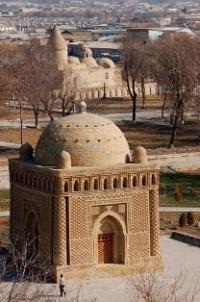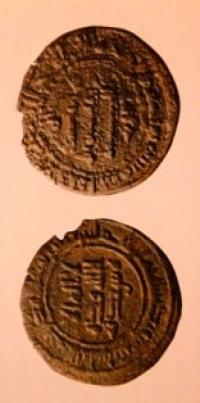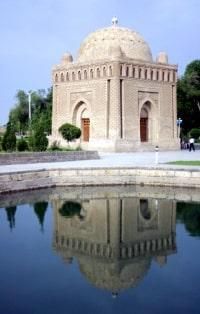Вы здесь
Riddle of the Samanid Mausoleum.



Individual tours of the monuments of Bukhara.
“We are all rotten, child, this is the universe's course.
We - like a sparrow, and death, like a hawk, waiting.
And it's too early, too late - any flower will wither, -
His float death of all creatures grind "
Rudaki, translated by V. Levik.
Cultural tourism in Bukhara.
West of the Registan Square in the sacred Bukhara in the greenery of the park, divided into the territory of the ancient cemetery “Naukand”, stands the perfect architectural creation - the mausoleum of Samanids. It is believed that this is the tomb of the Samanid rulers, built at the end of the IXth and early Xth centuries.
It is possible that the construction of the mausoleum was the answer of the Samanids to the challenge of the Abbasid Caliphate, where in 862 the mausoleum of Kubba al-Sulabiya was built over the grave of Caliph al-Muntasir.
For our topic it is important that, probably, these were the first Islamic mausoleums, in which the original pra-form “cube-dome” was embodied. The enigma of the Samanid Mausoleum is its richest brick decor, exquisite architectural composition, which many scholars refer to the pre-Islamic culture of ancient Sogd.
This contradiction gave grounds for considering versions of the earlier construction of the mausoleum and even interpreting it as a Zoroastrian temple of the Sun. Let's try to solve this problem on the basis of a semantic analysis of the symbolism of the Mausoleum.
In our opinion, the Mausoleum has in principle a symbolic composition in the timpanas of its arches, which is its essential cosmogram. This characteristic square sign is located symmetrically on both sides of the entrance on each side of the Mausoleum.
Each of the signs has in its structure four squares inscribed into each other. A circle is inscribed in the inner square. 40 "pearl-rings" are inscribed in the contour of the outer squares. Inside the squares there are also large and small "diptyre" signs.
Note that this sign composition is a flat projection of the bulk solution of the Mausoleum itself, i.e. their cosmograms are identical. This idea suggests, in addition to the connection "cube-square" and "dome-circle", a parallel between 40 "pearls" of the sign and 40 arched openings in the upper outer part of the walls.
In the mausoleum of Samanids everything, starting with the brick, the plan and the facades, is built on the square and its derivatives. This once again underlines the decisive significance of the square in the symbolism of the Mausoleum. It is possible that there is already a strong influence of the image of the Kaaba.
Then, taking the square as a basis, the mausoleum cosmogram can be decomposed into three signs, having a square as a basis:
1) Already known sign "circle in a square",
2) The sign "square inscribed in a square" and
3) The sign "two squares with forty pearls."
1) “Circle in a square” is the original pra-form of the mausoleum considered above.
2) A characteristic feature of the mausoleum is its openness like a chortak to all four directions of the world, which declared the possibilities of the source of its spiritual power.
Perhaps it is precisely this idea that expresses the inner square shifted in orientation, which is angled to indicate the location of the inputs. The wings above the arches of the Mausoleum are a traditional symbol of spirituality (remember the wings of angels).
The presence of these signs determines the overcoming of worldly vanity at the entrance to the Mausoleum, communion with the divine. The semantics of the sign “square inscribed in a square” can also be interpreted as a symbol of “unity of macro and microcosm”.
The movement from small to large square is an increase, which means the macrocosm and the infinity of the Universe. The reverse movement (reduction) represents the microcosm and the spiritual world. 3) “Two squares with forty pearls” address us to the symbolism of the sacral number 40.
In the Islamic tradition, the fate of the Soul at birth and death is connected with it: forty days the Soul enters the body of a newborn, forty days it does not leave the earth after death. Taking into account the purpose of the monument, it can also be assumed that the “forty pearls” of the Mausoleum symbolize “forty saints” - chilt (Persian, taj. - “forty people”), who protect the world. Uzbeks and Tajiks, Kazakhs and Kyrgyz have preserved ancient legends about “chilts” = forty orcs of “secret saints” or “intimate people”.
Later, they intertwined with the beliefs of the Sufi and Ismaili circle, introducing the Chiltan into the circle of Muslim saints. Then the square “fence” of 40 pearls on the sign means the protection of the Mausoleum from 40 powerful saints, the spiritual connection with them of the buried saint.
The image of 40 light sources (arched windows), illuminating the mausoleum, and therefore opposing the darkness, is in good agreement with the image of 40 saints who protect the mausoleum. In addition, the sacred number "forty" for the Maverannahr and Khorezm in the early Middle Ages was one of the characteristics of the secret union of senders (priestly corporation) Siyavush.
The image of Siyavush embodied the solar deity associated calendar-agrarian cult, the high priest of which in the pre-Islamic Bukhara was the ruler of the region. Thus, the cosmogram of the Samanids Mausoleum combines Islamic and pre-Islamic symbols.
This is one evidence of the dual belief of the population, which officially adopted the new Islamic faith, but continued to perform the “pagan” ritual, and the fact that dual faith was officially recognized by the Samanids.
Probably, the proclamation of the Samanids statehood independent of the Abbasid Caliphate in the 60s - 70s of the IXth century in the interests of cultural sovereignty and consecration of the power of the new ruling dynasty claimed local pre-Islamic religious ideas and symbols.
This explains the “paganism” of the Islamic mausoleum of the Samanids.
Enlightener:
"Temuriylar davri madanii Yedgorniklari". Tashkent, 2003, pp. 66 – 74. Bulatov M.S., Arapov A.V., Tuychieva Yu.G. Cosmograms of the early Islamic mausoleums of Central Asia.
Photos by
Alexander Petrov.







